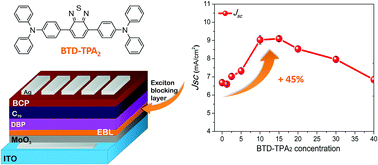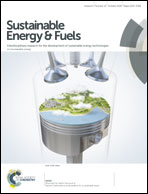Benzothiadiazole–triphenylamine as an efficient exciton blocking layer in small molecule based organic solar cells†
Abstract
We have designed a small molecule based on benzothiadiazole–triphenylamine moieties (BTD–TPA2), composed of an electron-poor benzothiadiazole core with two electron-rich triphenylamine arms. BTD–TPA2 was synthesized in a facile manner using a Suzuki cross-coupling reaction. The molecule was rationally designed to take advantage of the synergistic effect of BTD, which allows the formation of a favorable band gap material, and triphenylamine (TPA) moieties, which favour efficient hole extraction and transport properties. A thin layer of BTD–TPA2 was placed between the photo-active DBP/C70 layer stack and the MoOx electrical contact. With an optimized interlayer thickness of 35 nm, the attained photovoltaic properties were substantially superior to those of the reference devices. This has its origin in the dual functionality of BTD–TPA2, i.e., efficient exciton blocking and improved hole extraction at the anode contact. The obtained results led to an improved power conversion efficiency of 5.66% for a vacuum deposited bilayer DBP/C70 solar cell, which will be the new state of the art for bilayer DBP based solar cells.



 Please wait while we load your content...
Please wait while we load your content...